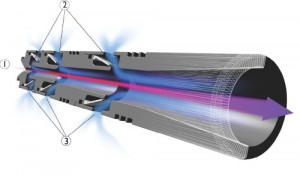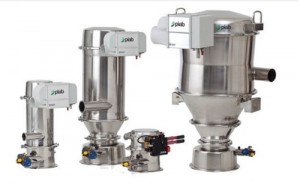
When compressed air (1) passes through the nozzles (2), air is pulled through with the stream of compressed air. Suction will be generated at the opening of each stage (3), resulting in vacuum.
When Piab set out to create its new piFLOWp line of conveyors, it wanted to improve capacity and energy efficiency by moving vacuum pump technology away from the multi-ejector. The goal was to reduce lead time and cost through modularization of both the conveyor and pump. This meant a side mounted pump versus the old top mounted pump. It meant a new body design.
So how does one design a vacuum ejector for scalable capacity? How can you simplify and reduce cost in the vacuum ejector manufacturing without sacrificing quality?
Piab’s solution was integrating its COAX technology into the conveyor. With COAX cartridges, compressed air is injected into the cartridges through special nozzles. The force of the compressed air leads to a sharp drop in static pressure. The result is an ejector that requires low feed pressure and can handle fluctuations in pressure feed lines all within a smaller design. The design team also integrated both the silencer and the central exhaust in the pump to create a better working environment. This design element simplified the disconnecting of the pump for service and maintenance.
Because the cartridges are smaller and more efficient than conventional ejectors, the design team was able to create a

The vacuum conveyors are designed according to USDA and GMP guidelines. All materials are FDA approved and all configurations can be delivered with an ATEX Dust certificate.
more flexible, modular and efficient vacuum system.
The cartridges provided the designers with three times more vacuum flow than a conventional system, while reducing energy consumption.
The design made it possible for the conveyor to give the user instant access to technical data, drawings and CAD files. This made the integration work much easier. Users could now change their configuration parameters online and see if the conveyor system fit into their application, instead of waiting weeks for a new drawing from the supplier.
Piab
piab.com
Filed Under: Pneumatic Tips